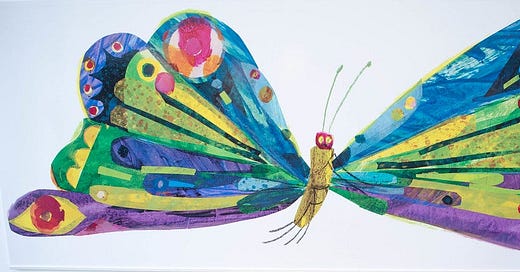Two things I have quicky learned as a parent to small children:
1. Children have many questions
2. I do not have as many answers
Recently at bedtime, I was reading the Eric Carle classic “The Very Hungry Caterpillar” to my 5-year old son. As we came to the final page with the butterfly’s unveiling, my son, ever curious, asked what happens in the days inside the cocoon when a caterpillar transforms into a butterfly. It turns out that we can add this to the list of things that I did not yet have the answer to. Despite hosting monarch caterpillars in jars and carboard boxes throughout my childhood, watching them build themselves into and then emerge from their chrysalis, their time inside was a private mystery to me.
As my son was coming up with different hypotheses of transformation (magic tricks? pooping out the wings?), he said “I wonder if it hurts like giving birth for them to become a butterfly.”
I wonder if it hurts like giving birth for them to become.
I was immediately reminded of a line from poet Andrea Gibson, “I said to the sun, ‘Tell me about the big bang.’ The sun said, ‘it hurts to become.”1 For those of us who have undergone significant shifts in identity, circumstance, or perception of the world, we know that these evolutions of the self can be quite uncomfortable.
We all have our moments of steady growth, and these are like the caterpillar’s stretching and molting of skins, shedding what no longer fits us. Our moments of deep transformation, however, are more intensive and all-encompassing of our lives, ideas, and beliefs.
It turns out that when a caterpillar settles into its chrysalis for transformation, it actually begins to digest itself. Nearly the entire caterpillar is melted away by enzymes, leaving only caterpillar goo and pieces called imaginal discs. These imaginal discs are cell groups that have the DNA to instruct the discs to grow into the various pieces of the butterfly- wings, antennae, etc. These directions on how to grow into a butterfly have been with the caterpillar all along, but they were blocked until now by a juvenile hormone, which at this point has also been digested. All that remains are these foundational directions to regrowth, and the energy2 to rebuild.
What does it take then for a human to be transformed? I don’t believe we can stubborn our way into conversion, and we can’t make new year’s resolutions to have a truly transformative year. Rather, transformation happens to us in time - when our constant practice or small moments of openness and gentleness align with the movements of the Spirit. When we allow ourselves to soften, removing all we’ve held tightly onto, we’ll realize the foundational pieces that direct our regrowth have been in us all along. Poet Rainer Marie Rilke writes that “the future must enter you long before it happens.”3 With transformation, we make space for the building of these futures we have carried with us.
Times of transformation will cost us, burning away everything else and leaving only the uninhibited directions on how to grow into our most whole selves. We don’t get to hold onto it all and still be changed.
What does this mean for monastics (and those of us committed to living similarly) who take a vow of conversion? Not just a vow of growth, but a vow of being open to the melting away and the rebuilding, directed by the future that has been with us since the beginning-
to answer my son’s question, it probably is a lot like a birth.
From their poem I Sing the Body Electric, Especially When My Power is Out
aka liquified caterpillar goop
I heard this quote for the first time this week in Jessie Hubert’s Epiphany reflection for FutureChurch - https://futurechurch.org/lectionary/year-c/the-epiphany-of-the-lord/
The source of my very limited butterfly knowledge: https://www.columbiatribune.com/story/news/2021/10/13/shocking-metamorphosis-caterpillar-butterfly/6002608001/
Michelle Scully is the program and events coordinator for the Benedictine Sisters of Erie. Contact her if you are interested in contributing a piece to this space, or becoming connected to the Erie Benedictines through a variety of ways, including the Benedictine Peacemakers monastic immersion. Michelle’s personal substack can be found here.








Beautiful!
The transformation of a caterpillar to a butterfly is an amazing miracle created by God. He is definitely the Master of creation. We humans grow and change over years and experiences, and we make life decisions based on our development over time. As we make our life decisions, we must remember that our sole purpose on earth is to know God, love God and to serve God so that we can be happy with Him in the next.